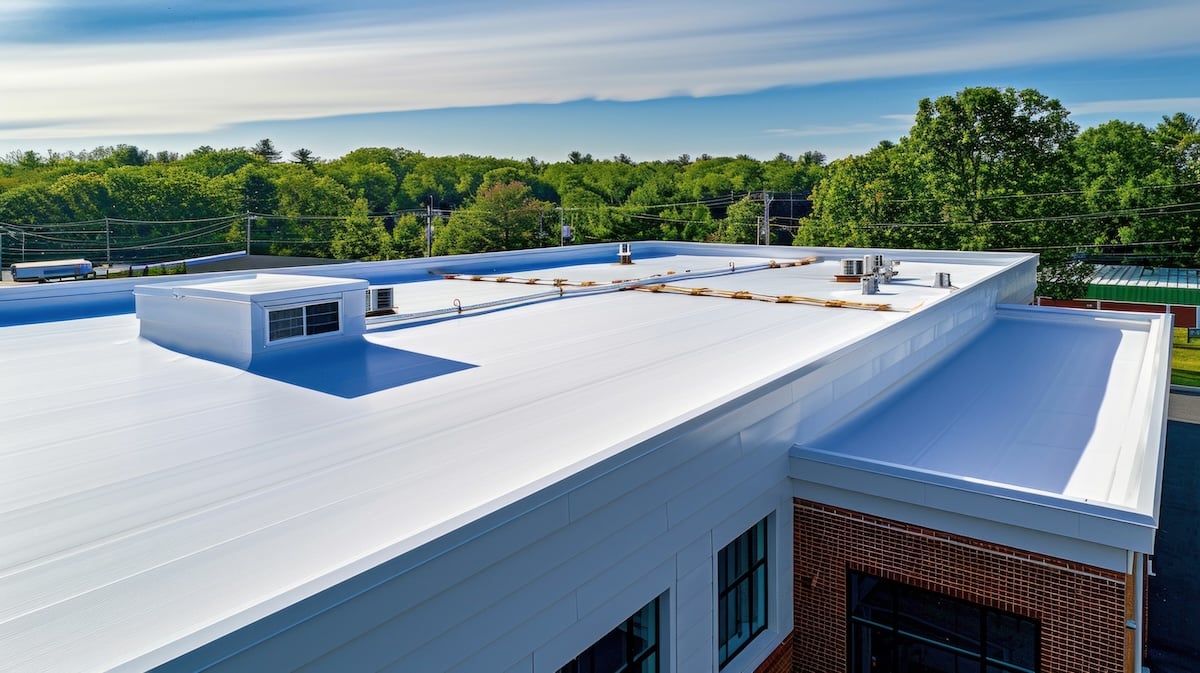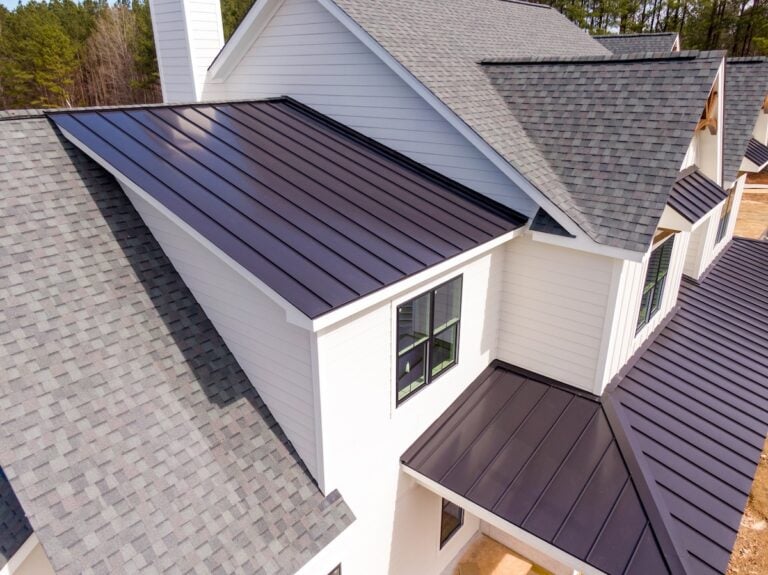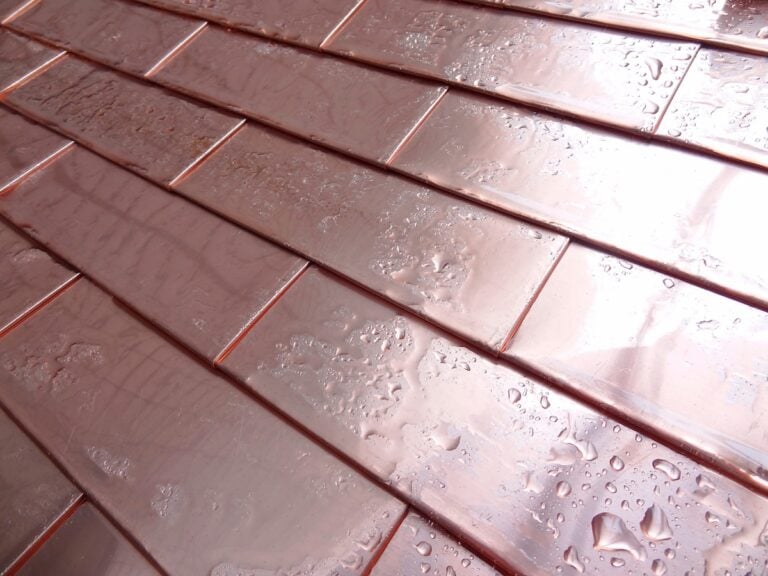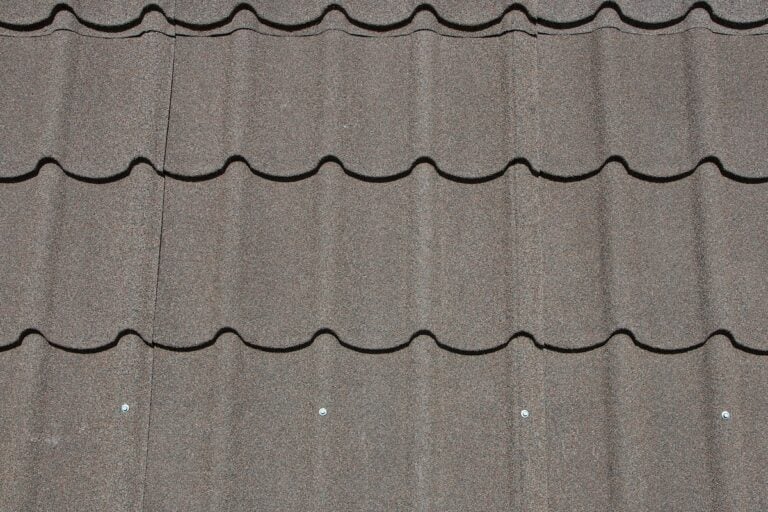If you’re considering single ply roofing for your commercial building, you’re looking at one of the most trusted solutions for flat or low-slope roofs. This versatile system is popular in warehouses, office complexes, retail centers, and other large-scale properties for its balance of durability, cost-efficiency, and low maintenance needs.
In this guide, you’ll learn:
- What single ply roofing systems are and how they work
- Benefits specific to commercial and industrial properties
- How installation and long-term care are handled
🤔 What Is Single Ply Roofing?
Single ply roofing refers to a category of flexible, waterproof membrane systems used to protect flat or low-slope roofs. These membranes are installed in a single layer, offering excellent resistance to weather, chemicals, and UV exposure.

Types of Single Ply Membranes
There are three main membrane types used in commercial roofing:
- TPO (Thermoplastic Polyolefin): One of the most popular options for modern facilities, TPO offers strong UV resistance, heat reflectivity, and cost-effectiveness.
- EPDM (Ethylene Propylene Diene Monomer): Often called “rubber roofing,” EPDM is known for its flexibility and exceptional weather resistance, making it ideal for colder climates.
- PVC (Polyvinyl Chloride): PVC offers outstanding chemical resistance, which makes it perfect for restaurants, manufacturing sites, or buildings with rooftop grease traps or contaminants. Learn more in our PVC roofing guide
How It’s Installed
Single ply membranes are typically applied in one of three ways: fully adhered with adhesives, mechanically fastened with screws and plates, or ballasted with stone or pavers. Seams are sealed with heat welding (TPO/PVC) or adhesive tape (EPDM), forming a watertight barrier. The method chosen depends on your building type, wind exposure, and project goals.
⭐️ Key Benefits of Single Ply Roofing
For building owners and facility managers, single ply roofing offers numerous long-term advantages over older built-up or modified bitumen systems.
Cost Efficiency
Installation is faster and requires fewer layers than traditional roofing systems, which reduces labor costs. Over the life of the roof, single ply membranes offer fewer repair needs and lower energy bills—especially when reflective materials like TPO are used. Routine commercial roof cleaning further reduces repair costs and extends the membrane’s service life.
Lightweight and Versatile
Single ply roofing systems are ideal for retrofitting older buildings or upgrading without reinforcing the structural deck. They’re light, flexible, and adapt easily to complex roof shapes or multiple penetrations, such as HVAC systems or vents.
Energy Performance
White or reflective single ply membranes help reduce heat absorption and improve your building’s thermal efficiency. This can lower cooling costs in summer and support energy-efficiency initiatives or LEED certifications.
Durability and Low Maintenance
These systems resist UV rays, chemical exposure, tears, and ponding water. With proper installation and care, single ply membranes can last 20 to 30 years, requiring minimal attention compared to more complex systems.

✅ 5 Step Installation Overview for Commercial Buildings
Here’s how the typical commercial single ply roofing installation process unfolds:
- Inspection and preparation: Your contractor examines the existing roof for damage, drainage problems, or substrate issues and determines whether tear-off or overlay is needed.
- Substrate repair or replacement: Damaged areas of insulation, decking, or flashing are repaired to ensure a flat, solid surface.
- Insulation and vapor barrier application: Insulation layers are added to improve energy performance, and a vapor barrier may be installed depending on your climate and building design.
- Membrane installation and seam sealing: The chosen membrane is rolled out, secured using fasteners or adhesives, and seams are sealed using heat or tape to create a continuous watertight layer.
- Edge detailing and final inspection: Roof edges, penetrations, and flashing details are sealed and reinforced before a full inspection ensures proper installation and code compliance.
🛠️ Maintenance & Inspection Best Practices
Although low-maintenance, single ply roofs still benefit from routine care to extend their life.
- Schedule seasonal inspections: Professional checkups twice a year (spring and fall) help spot seam separation, debris buildup, or mechanical damage before it becomes costly. For reliable inspections and seasonal care, our commercial roofing in Alexandria team ensures your system meets performance standards year-round.
- Clean debris regularly: Leaves, tools, or standing water can affect membrane performance. Clear drains and walkways to keep the surface functional. Our Arlington roofing contractors are experts in keeping systems clean and functional.
- Monitor rooftop traffic: If your roof supports frequent maintenance or HVAC visits, consider adding walk pads or reinforced paths to prevent wear and tear.
- Address issues promptly: Small punctures or loose flashing can escalate quickly if not repaired. Have a go-to contractor for timely maintenance.
💪 Is Single Ply Roofing Right for Your Property?
While single ply roofing is an excellent fit for most flat and low-slope commercial roofs, it’s not a one-size-fits-all solution.

Considerations for Decision-Makers
Evaluate your building’s climate exposure, budget, energy goals, and expected roof traffic. For example, if your property houses a food service operation or lab, PVC may be the best fit. If budget and UV reflection are top priorities, TPO is likely the smarter option.
Retrofit Opportunities
Many aging buildings with built-up or tar-based systems are prime candidates for a single ply retrofit. These systems can often be installed without full tear-off, saving time and costs while improving performance. Many older properties are great candidates for retrofits—our Great Falls roof installation experts can determine if single ply is right for you.
✅ Request an Estimate for Commercial Roofing Today
Single ply roofing offers proven performance for commercial properties—and when it’s installed by the right team, it can protect your building for decades. Whether you’re replacing an outdated system or designing a new build, we’re here to help.
Contact Springfield Roofing & Sheet Metal Inc. today to discuss your project. Our team will guide you through the best materials, options, and solutions for your specific property.






